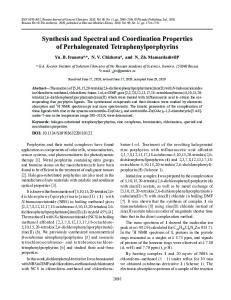Optical/Infrared, Atmospheric Absorption/Transmission, and Media Spectral Properties
- PDF / 7,774,579 Bytes
- 94 Pages / 595.276 x 790.866 pts Page_size
- 72 Downloads / 320 Views
OBSERVATIONAL PLATFORMS, AIRCRAFT, AND UAVS Jeffrey Myers NASA/Ames Research Center, Airborne Science and Technology Laboratory, University of California, Santa Cruz, Moffett Field, CA, USA
Synonyms Airborne platforms; Remote sensing aircraft; Suborbital platforms Definition Airborne observational platforms are any aircraft, manned or unmanned, which is equipped to obtain remotely sensed data or in situ atmospheric samples above the surface of the Earth. Introduction Airborne platforms are typically used to obtain observations of high spatial or temporal resolution that cannot be practically achieved with satellite- or ground-based systems. These include remote sensing observations of dynamically evolving events (e.g., volcanic eruptions or convective weather systems) which could not be made by satellites due to their fixed revisit schedules or in situ air sampling of atmospheric constituents at varying altitudes. Because they can selectively operate during clearsky conditions, they are also often used for remote sensing in areas which have persistent cloud cover. Imagery in some tropical, mountainous, and arctic regions, for example, cannot be obtained from polar-orbiting satellites on any regular basis. The spatial resolution of imagery obtained from an airborne platform can be precisely controlled by varying the altitude of the aircraft above the ground. Pixel sizes
produced from a sensor with a 2.5 mrad instantaneous field of view (IFOV), for example, can thus be varied between 3 and 50 m with the same instrument, when operated at altitudes of 1,200 and 19,800 m, respectively. This variability allows the imagery to be tailored to the requirements of the specific phenomenon being studied. Most satellite systems, especially those with the infrared spectral bands of interest to earth scientists, are designed for broadscale global observations at fixed spatial resolutions, which may be too coarse for many detailed geophysical process studies. Spatial resolutions of airborne infrared imaging systems can exceed 3 m and can be as high as 1 cm in the visible and near-infrared wavelengths, depending on platform altitude. Airborne platforms are also used as test beds for new instrument development. They provide an economical method of testing prototype satellite sensors prior to launch and also for collecting the empirical data needed to develop the associated retrieval algorithms for new orbital systems. Once a satellite system is placed in orbit, airborne sensors are often used to conduct simultaneous, high-resolution observations for data validation and instrument calibration purposes.
Overview of platform types Manned aircraft A wide variety of airborne platforms are used for Earth observations, ranging from small single-engine propeller planes with minimal modifications to large specially adapted multiengine commercial and military reconnaissance aircraft. Unmanned Aerial Vehicles (UAVs), airships, and balloons also fill unique observational niches. These platforms are modified to varying degrees to accommodate e
Data Loading...











